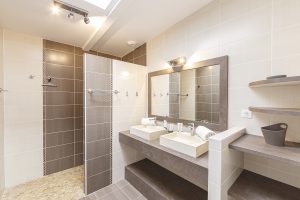Successful interior photography for real estate is an image that showcases an interior space in an attractive and professional way, encouraging potential buyers or tenants to become more interested in the property. Here are the main aspects that contribute to successful interior photography for real estate and/or vacation rentals.
Home staging: Before taking photos, it’s essential to prepare the space. This includes cleaning, de-cluttering and even arranging furniture to create a welcoming, spacious atmosphere. Accessories such as cushions, plants and artwork can add an elegant finishing touch. Curtains should be hung straight, avoiding creases, garbage cans are often too much, and I’m careful about personal photos in frames (especially with children). If it’s in the bathroom, lower the toilet bowl and remove the toilet paper and brush for aesthetic reasons. The kitchen should also be the focus of attention, avoiding the clutter of superfluous objects for the photo shoot.
Composition: Photographs must be carefully composed. Using straight lines, avoiding distorted angles and choosing shooting angles that show the space at its best are common practices. Photos should give an impression of space and fluidity. The camera should be at about the same height as the door handles, so as to have the same proportion between ceiling and floor.
Lighting: Lighting is crucial for high-quality photos. Natural light is preferred, so it’s advisable to shoot during the day with curtains open to maximize light entry. If necessary, use artificial lights to balance the lighting and avoid harsh shadows. I always recommend turning on all interior lights, such as spotlights, halogens, ceiling lights, mood lights, kitchen hood lights, etc., to create a cozy, warm atmosphere for photos intended for holiday rentals.

Equipment: I use a full-frame camera with a wide-angle lens (up to 12 mm) that allows me to capture more space and give a better idea of the layout of rooms. My tripod is essential to avoid blurred photos and ensure stable shots, especially when using bracketing, which generally involves 3 to 5 exposures: that is, from the most overexposed to the most underexposed, passing through several other values, in order to recompose the photos for perfect light homogeneity.

Post-processing: After the photos have been taken, image processing is required to adjust brightness, contrast and color. Software such as Photomatix is useful for recomposing the bracketing, then applications such as Adobe Lightroom or Photoshop are used to retouch the photos and correct minor imperfections.

Details: Details make all the difference. Taking photos of a home’s unique or attractive features, such as a fireplace, decorative moldings or an updated kitchen, can attract buyers’ attention.

Varied perspectives: Taking photos from different angles and heights can offer a better representation of the space and enable potential buyers to better visualize the layout and dimensions of the rooms.

In short, a successful interior photograph for real estate is one that presents the property in an attractive and realistic way, highlighting its strong points and creating a positive impression that encourages buyers or tenants to visit the property.
Stéphane Clément
